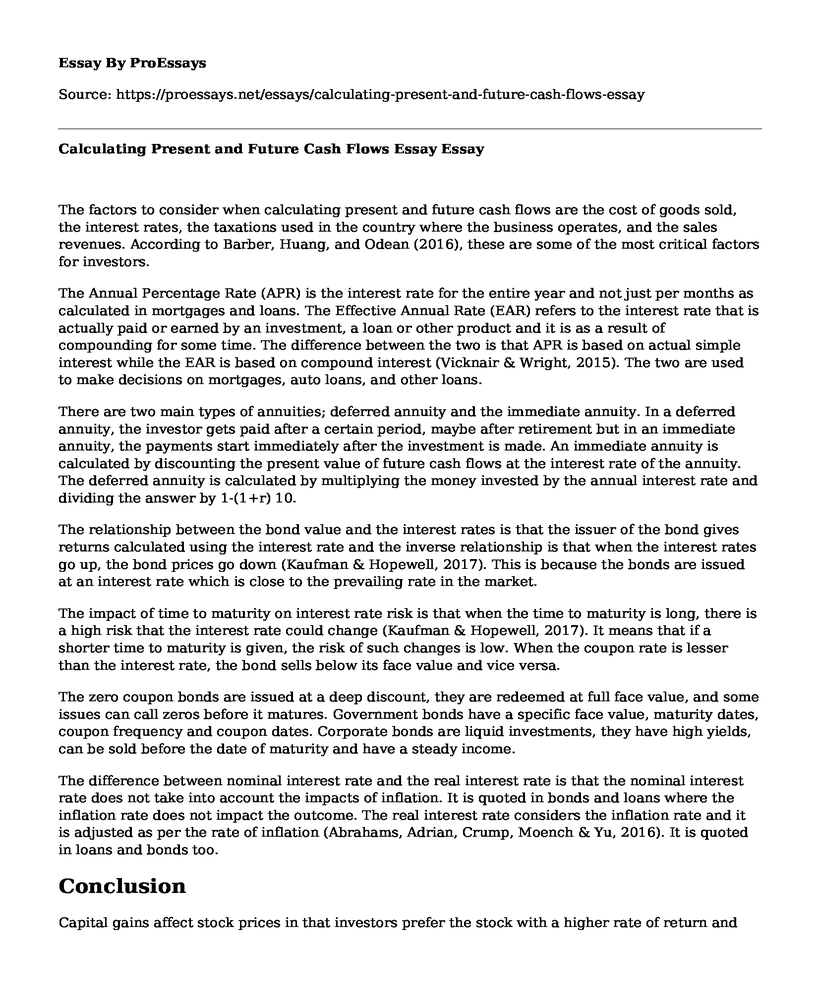The factors to consider when calculating present and future cash flows are the cost of goods sold, the interest rates, the taxations used in the country where the business operates, and the sales revenues. According to Barber, Huang, and Odean (2016), these are some of the most critical factors for investors.
The Annual Percentage Rate (APR) is the interest rate for the entire year and not just per months as calculated in mortgages and loans. The Effective Annual Rate (EAR) refers to the interest rate that is actually paid or earned by an investment, a loan or other product and it is as a result of compounding for some time. The difference between the two is that APR is based on actual simple interest while the EAR is based on compound interest (Vicknair & Wright, 2015). The two are used to make decisions on mortgages, auto loans, and other loans.
There are two main types of annuities; deferred annuity and the immediate annuity. In a deferred annuity, the investor gets paid after a certain period, maybe after retirement but in an immediate annuity, the payments start immediately after the investment is made. An immediate annuity is calculated by discounting the present value of future cash flows at the interest rate of the annuity. The deferred annuity is calculated by multiplying the money invested by the annual interest rate and dividing the answer by 1-(1+r) 10.
The relationship between the bond value and the interest rates is that the issuer of the bond gives returns calculated using the interest rate and the inverse relationship is that when the interest rates go up, the bond prices go down (Kaufman & Hopewell, 2017). This is because the bonds are issued at an interest rate which is close to the prevailing rate in the market.
The impact of time to maturity on interest rate risk is that when the time to maturity is long, there is a high risk that the interest rate could change (Kaufman & Hopewell, 2017). It means that if a shorter time to maturity is given, the risk of such changes is low. When the coupon rate is lesser than the interest rate, the bond sells below its face value and vice versa.
The zero coupon bonds are issued at a deep discount, they are redeemed at full face value, and some issues can call zeros before it matures. Government bonds have a specific face value, maturity dates, coupon frequency and coupon dates. Corporate bonds are liquid investments, they have high yields, can be sold before the date of maturity and have a steady income.
The difference between nominal interest rate and the real interest rate is that the nominal interest rate does not take into account the impacts of inflation. It is quoted in bonds and loans where the inflation rate does not impact the outcome. The real interest rate considers the inflation rate and it is adjusted as per the rate of inflation (Abrahams, Adrian, Crump, Moench & Yu, 2016). It is quoted in loans and bonds too.
Conclusion
Capital gains affect stock prices in that investors prefer the stock with a higher rate of return and this determines the demand and prices. The dividends affect stock prices in that if they are high, the demand for the stock is high and prices also go high. The opposite also happens.
References
Abrahams, M., Adrian, T., Crump, R. K., Moench, E., & Yu, R. (2016). Decomposing real and nominal yield curves. Journal of Monetary Economics, 84, 182-200.
Barber, B. M., Huang, X., & Odean, T. (2016). Which factors matter to investors? Evidence from mutual fund flows. The Review of Financial Studies, 29(10), 2600-2642.
Kaufman, G. G., & Hopewell, M. H. (2017). Bond price volatility and term to maturity: A generalized respecification. In Bond Duration and Immunization (pp. 64-68). Routledge.
Kaufman, G. G., & Hopewell, M. H. (2017). Bond price volatility and term to maturity: A generalized respecification. In Bond Duration and Immunization (pp. 64-68). Routledge.
Vicknair, D., & Wright, J. (2015). Annual Percentage Rate and Annual Effective Rate: Resolving Confusion in Intermediate Accounting Textbooks. American Journal of Business Education, 8(3), 207-216.
Cite this page
Calculating Present and Future Cash Flows Essay. (2022, Jul 19). Retrieved from https://proessays.net/essays/calculating-present-and-future-cash-flows-essay
If you are the original author of this essay and no longer wish to have it published on the ProEssays website, please click below to request its removal:
- Essay on Important Changes for Businesses and Managers as They Relate to SOX
- Types of Accounts Maintained by a Business Essay Example
- Effect of Bonds' Riskiness on the Interest Rate - Essay Sample
- Importance of Accountability for Government - Essay Sample
- Educational Technology Audits Essay Example
- Kay Jewelers: Retail Repayment Credit Agreement Paper Example
- Preferred Stock: Hybrid Security Between Bonds & Common Stock - Essay Sample







